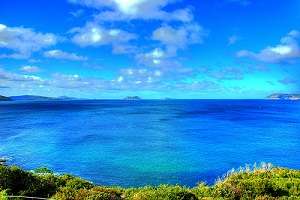As well as King George Sound (pictured), settlement arrays will be anchored at Broome, Dampier, Carnarvon, Geraldton, Garden Island and Esperance. Credit: Alan Lam
The incidence of marine pests in Albany's King George Sound will be examined for the first time this summer in research by a UWA plant biology and Oceans Institute PhD student.
Tiffany Simpson has deployed two settlement arrays from Albany Port that will provide habitat for invasive aquatic organisms until February, when they will be removed and analysed.
The devices feature two plastic plates that larvae can attach to and form colonies on during the peak marine pest recruitment period when ocean temperatures are at their highest.
Ms Simpson says marine pests grow quickly, outcompete native species and have the potential to damage the marine environment and infrastructure and deplete important fish and aquaculture stocks.
She is particularly interested in a colonial ascidian Didemnum perlucidum that originates from the Gulf of Mexico.
"It is officially a tropical species but they have found a lot of it in Perth boat harbours and the Swan River," she says.
"It has been introduced into WA but we don't know when.
"It might have been triggered during a heat wave a few years ago when there were very high ocean temperatures … once colonies have been established they are able to survive in cooler waters."
She says the discovery of Didemnum perlucidum in the Swan River is the first time the organism has been found growing in sea grass instead of on boat hulls or harbour structures.
"Albany is considered a high risk area for marine pests due to vessels coming into the port and potentially bringing new species with them in their ballast water or growing on the hull," she says.
Albany is the most southern of seven locations in the state where the incidence of marine pests is being investigated, with settlement arrays also anchored at Broome, Dampier, Carnarvon, Geraldton, Garden Island and Esperance.
"I am looking at the diversity, abundance and biomass along the full range of the coastline," Ms Simpson says.
"I hope not to find anything on the target species list for the national system for marine pests but it is a bio-security monitoring tool so if it is here we will find it and hopefully be able to do something about it."
"I am hoping to also see some patterns between that latitudinal gradient … what grows in the water here compared with what grows in the water in Broome, and establish a baseline for future research."
Ms Simpson says the project is in collaboration with the Department of Fisheries' bio-security monitoring program.
Provided by Science Network WA























